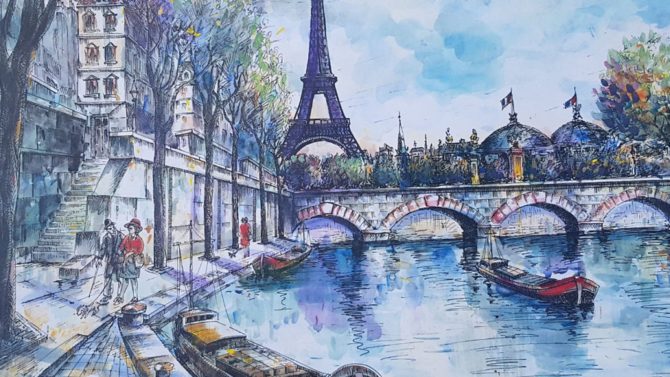Memories of the magic of visiting Paris

What’s your favourite way to spend a day in the French capital? Regular visitor Dan Daly relives an unforgettable experience involving a Renoir painting, a pavement café and an impromptu musical performance

I go to Paris whenever I get the opportunity. Any reason at all will suffice. I even went to work on one occasion, but I am now convinced that as far as I am concerned, Paris is not a place for working. I found the teacher exchange programme tough going. One particular day I was feeling tired and just a little fed up and in common with many a disaffected student from the nearby Sorbonne, I headed off down into that maze of narrow streets famously known as the Latin Quarter seeking a little diversion.
In one of the many art shops that decorate the area, I saw a print of a painting that always focuses my attention. Pierre-Auguste Renoir’s Dance at Le Moulin de la Galette is a painting famously purloined by Rod Stewart for his album A Night on the Town and it features a bright, colourful, open-air dance scene. Renoir painted it in 1876 in what was still rural Montmartre and it depicts working-class Parisians dancing, drinking and dining on an enchanting, festive Sunday afternoon. In true Impressionist form, Renoir shows what the eye sees at a glance. Only the heads of some people in the foreground are painted in detail and beyond that the figures melt away into movement and sunlight in a unifying and flowing rhythm. It conjures up the colour, gaiety and ease of Paris. In short it sums up why I return so often.

I spent some time exploring the dark, medieval church of Saint Sulpice which was featured in The Da Vinci Code. It is almost as big as Notre-Dame. I discovered that the Marquis de Sade was baptized in the church in 1740 and Victor Hugo and Adele Foucher were married there in 1822. I then headed off in the direction of the Rue de l’Odéon to find the café where Ernest Hemingway, James Joyce, T.S. Eliot, Scott Fitzgerald and many other famous writers hung out.
The day was developing a slight touch of a drizzle, so I secured a seat under a dependable awning at a brasserie in the Place de l’Odéon. An elderly gentleman sipped a small cup of coffee and stared into the square. To my right a young couple referred to travel books and maps when they were not searching each other’s eyes. With a delicate flourish of movement, the waiter placed two beers on their table, slipped the bill under the ashtray and in a final balletic movement sashayed away to serve elsewhere.

The other waiter served my café au lait and I sat back and watched Paris go by. There were elegant women of all ages, many accompanied by very petite dogs, men with flowing scarves, others with attitude and tourists with plans, passing by. I sometimes think that many of these pavement characters come from some French central casting unit for they appear to form part of an endless, entertaining cinema reel.
Just a few metres away from me there was a piano player playing a fine solo. People stopped, swayed, tapped their feet, nodded and hummed. The light rain had cleared and the sun was shining again. I was being royally entertained, and I ordered a beer. A dapper looking man walked up to the piano player, doffed his hat, slipped his coat from his shoulders, placed them on the piano and spoke to the pianist. He looked like a small version of Louis Armstrong and although I have no idea how big Louis was, he always seemed to fill the TV screen. The pianist then set off into a boogie-type jazz tune and ‘Little Louis’ as I shall call him launched into song. Musician and singer became one in a harmony that quickly drew a large gathering of admirers and brought the sidewalk to a standstill. For those minutes they were the sole focus of our attention.
I glanced at the faces in the semi-circular audience. They seemed mesmerized and entranced by this impromptu, spontaneous performance. The music flowed, rocked, soothed and excited. It was extraordinary yet paradoxically so natural. Renoir would have loved it, would have been enchanted and would have admired the flowing rhythm, the freedom of artists to express themselves with a responsibility to only their own sensibilities.
The performance gave the impression of existing in a time zone all of its own as they sang and played and swayed. Then it finished. They hugged each other and Louis donned his hat and coat, picked up his stick and vanished into the crowd. No one had time to shout “encore” and the piano player returned to playing alone. It was a magical, uplifting, surreal moment, a scene that deserved the Impressionist brush of Renoir and not the scratchy etchings of someone who didn’t even ask what the tune was called.
There is no recording of the performance, no portrayal of the occasion. But every time I look at Renoir’s painting, I see that audience of privileged passers-by again, a little hazier now, melting away into shimmering movement and sunlight. You know I never got to visit that bookshop-cum-coffee shop so beloved by the famous writers. Now there’s another good reason to return.
___________________________________________________________________
You might also like….
In the footsteps of Pierre-Auguste Renoir
Share to: Facebook Twitter LinkedIn Email


